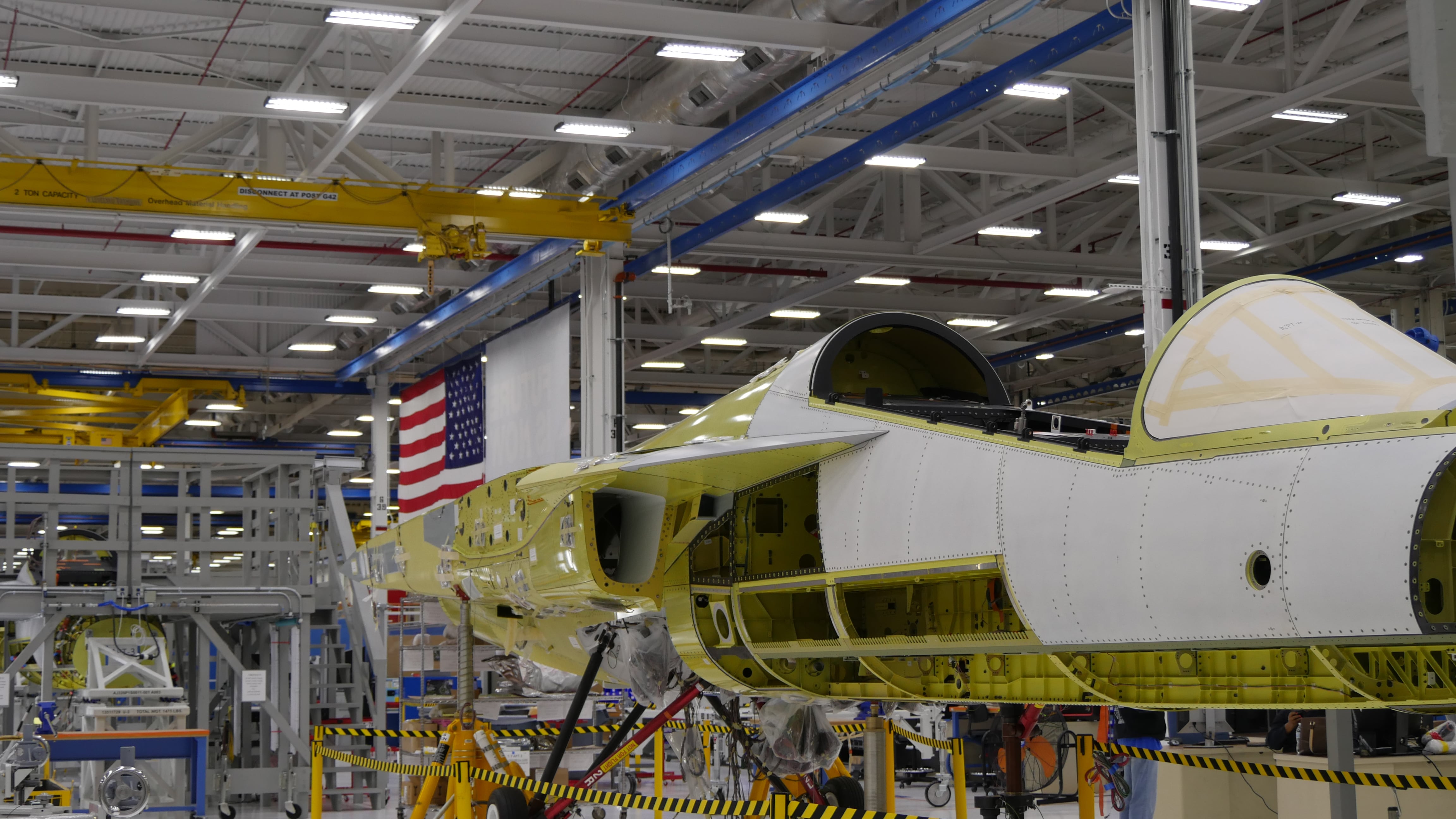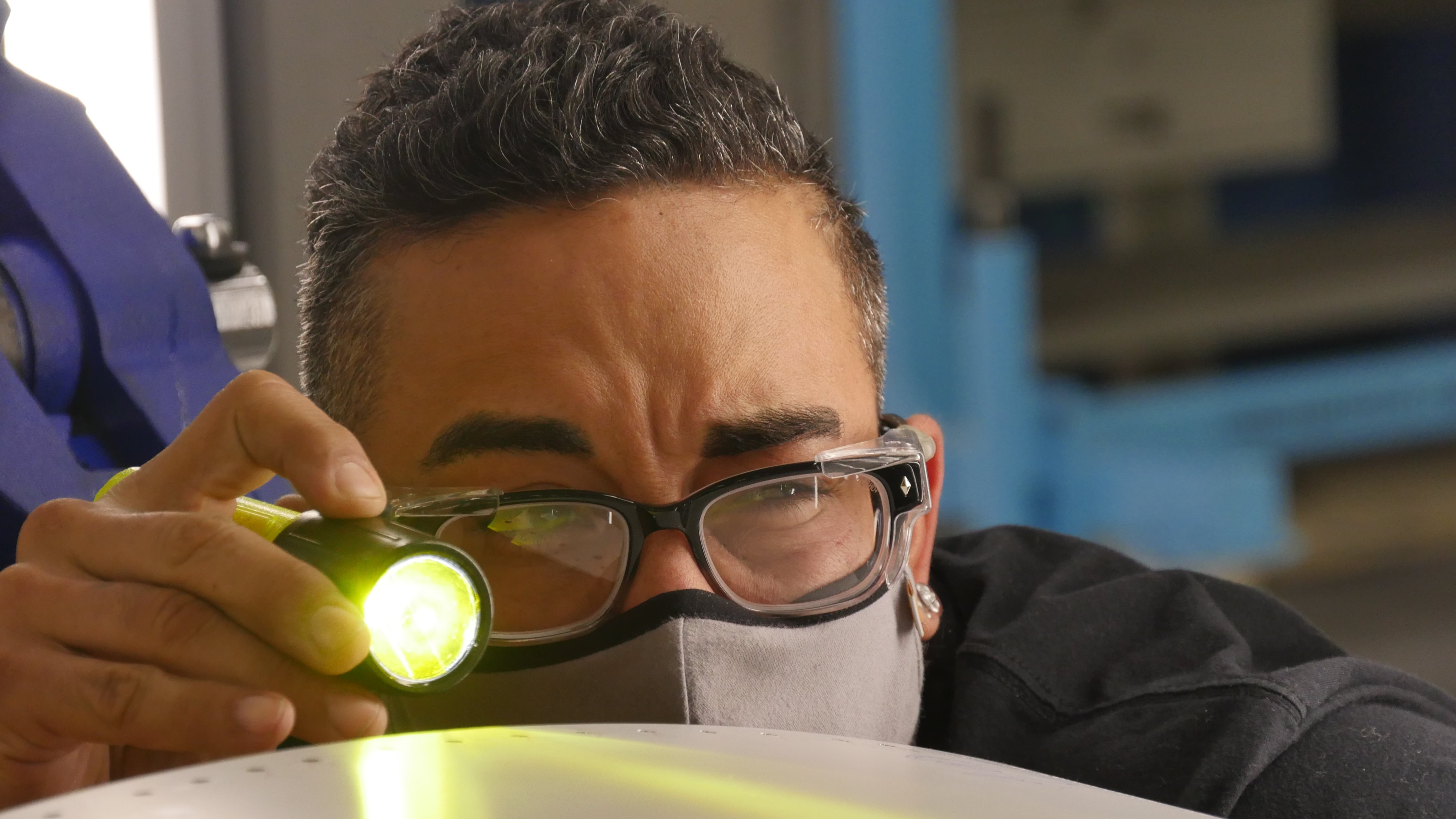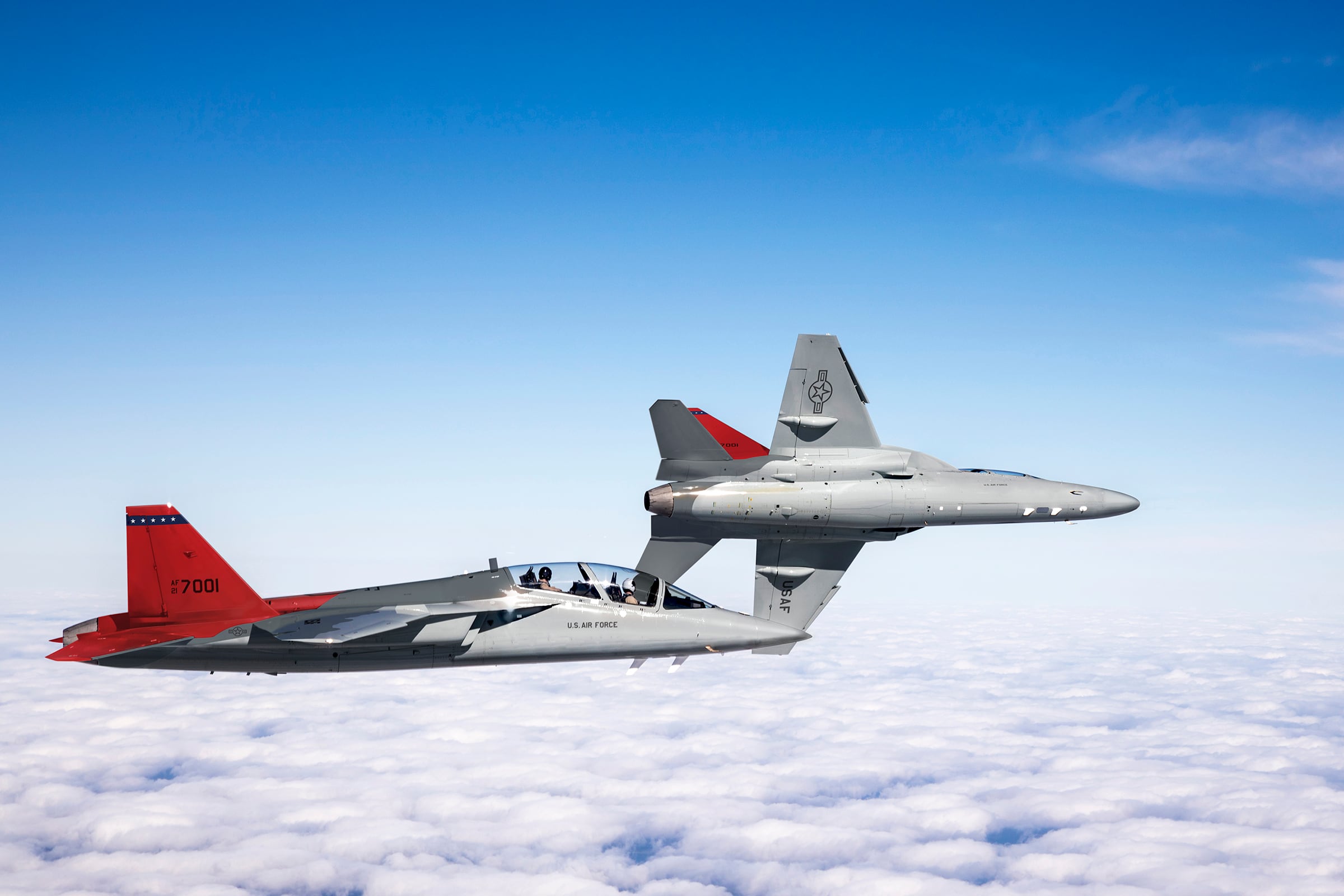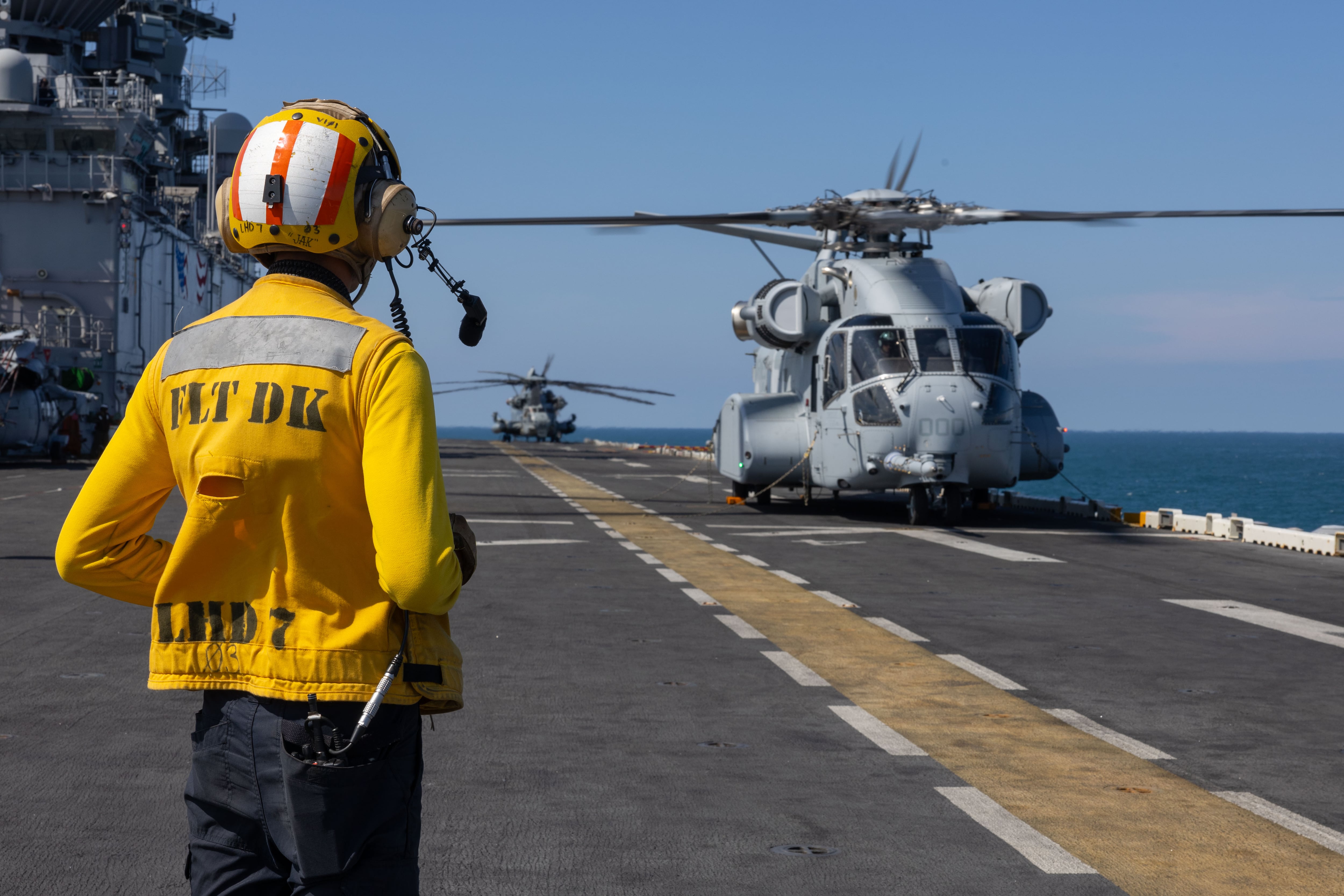ST. LOUIS, Missouri — In a factory in St. Louis that once helped launch the U.S. space program, the Air Force’s next generation of training aircraft is taking shape.
Boeing’s T-7A Red Hawk is still years away from reaching initial operating capability. But during a Wednesday visit to the factory where the new plane is being assembled, Boeing officials were bullish on its future potential — not just as a trainer to teach new pilots, but also as a model for how to build future aircraft.
The high-tech methods Boeing used to design and build the T-7 are saving time, simplifying processes, improving quality and cutting down on defects, company officials told reporters.
“Everything’s in 3D, everything’s digital,” Boeing vice president and T-7 program manager Paul Niewald said. “It’s an authoritative source of data. So our technical publications, our flight manuals, our service manuals, they all use the same data that the engineers are using, that our mechanics are using to build the airplane.”
In 1960, when the St. Louis facility was run by Boeing predecessor McDonnell Aircraft, engineers in white coveralls and caps assembled Mercury capsules in a clean room here. And more than half a century ago, this factory cranked out scores of F-4 Phantoms for the military to wage war in Vietnam, hitting its single-month production peak at 72 in June 1967.
But now, Boeing sees a highly digital future for aircraft design and production unfolding here, with the T-7 paving the way. And manufacturing lessons learned from the T-7 have already helped in the creation of the Air Force’s new F-15EXs and the secretive Next Generation Air Dominance fighter, said Matt Giese, Boeing’s chief test pilot for the F-15EX.

The Air Force in 2018 awarded Boeing a $9.2 billion contract to build 351 of the trainers to replace the aging T-38 Talon.
Boeing used model-based engineering tools and advanced manufacturing techniques to go from the concept of what would become the T-7 to its first flight in three years, Niewald said.
Advancements in high speed computing allowed Boeing to carry out computational fluid dynamics analyses and get aerodynamic characteristics to the plane’s designers earlier than usual, he said. This shaved seven to nine months off the typical process, in which wind tunnel models would have been used to gather that information.
It wasn’t the first time model-based engineering and 3D tools were used to design a plane, but Boeing used them to a greater extent than ever before. The digital design process meant Boeing could know exactly how the parts would align and fit together and precisely where all the holes needed to go. That meant the supplier could pre-drill all the holes so they’d be fastener-ready upon delivery to Boeing’s factory — meaning no need for drilling on the T-7 line.
Boeing said this approach allows it to both improve the quality of its build and cut down on mistakes such as incidents of foreign object debris — a problem that plagued the company’s production of the KC-46 in 2019 and led to a temporary delivery halt and grounding of the Pegasus on Boeing’s production line.
If there’s no drilling on the line, Niewald said, there’s less risk of metal shavings or other debris that need to be swept up afterwards and could cause problems if missed. Concerns about FOD are omnipresent, with signs urging mechanics to watch out for debris posted throughout the facility.
“By having a fastener-ready design, we’ve eliminated a lot of the touch labor and the defects that go along with that,” Niewald said. “Drilling on assembly is the No. 1 defect that you usually find in a traditional line.”
Pre-drilling parts before they reach Boeing’s facility also yields another benefit: A significantly quieter workplace. When Boeing built its first two T-X airplanes for the competition, Niewald said, the hangar was so quiet the mechanics could even, for the first time, ask for music to be played over the loudspeaker.
The factory was also relatively quiet the day of the reporters’ visit, aside from conversations and the hum of machinery as mechanics worked on T-7s, MQ-25s and other aircraft. Towards the end of the visit, someone piped in AC/DC’s “Back in Black,” echoing throughout the cavernous factory.
Identical airplanes, no shims
The precision of the model-based design also allows the T-7′s forward fuselage sections, built in St. Louis, to be quickly and easily combined with the aft sections built by Saab in Sweden, Niewald said — far faster than a traditional build would.
Saab is moving its production of the T-7 aft fuselage to a newly-opened facility in West Lafayette, Indiana, to make the shipments to St. Louis easier. Saab’s Swedish facility has three more fuselages to build, after which it will ship its remaining equipment to Indiana.
The precise fabrication of parts also means the T-7 can be put together without needing shims, the thin pieces of materials inserted to fill gaps between panels, Niewald said.
“The first two airplanes we built [are] the most identical airplanes we’ve ever built at the site,” Niewald said. “And that’s going to continue with the shimless design; everything will be the same.”
This doesn’t just pay off in the build process, he said, but also in sustainment. As the T-7 needs maintenance or modification in years to come, he said, maintainers will find all parts for the plane are exactly the same, making it easier to pop a new one in without adjustment. Niewald said Boeing brought the mechanics who would build the T-7 and the maintainers who would sustain it into the clean-sheet design process early on.

That paid off in a simple, but effective, ergonomic change in how mechanics and maintainers access the T-7′s avionics, Niewald said. Older planes often had the door panels covering avionics swing up, which forced maintainers to stoop down to make repairs or modifications.
But maintainers asked the T-7 designers if the avionics doors could instead swing down, allowing easier access and giving their backs a break.
Boeing’s mechanics also use touch-screen tablets to guide them as they build the T-7, so they have work instructions and specifications at the tap of a finger. That way they can quickly look up, for example, what size clamp is needed on a certain hose instead of walking over to consult paper blueprints on a table.
The simulators used to teach pilots how to fly the T-7 were built using the same engineering data as the aircraft itself, as well as running the same operational flight program software. This means in the future, when the aircraft gets a software update, the simulator’s software will be updated in a single push, Niewald said. Other aircraft’s training devices usually get upgraded software a year or two after the plane, creating a gulf in what pilots are learning on versus what they actually fly.
Supply chain woes
As with the rest of the defense industry, supply chain problems spawned by the pandemic have complicated and delayed T-7 production, Niewald said. It was particularly challenging because the program relies on a brand new supply chain that was just starting up as the pandemic erupted.
Niewald said the program lost about seven months due to a variety of supply chain issues, including shortages of microchips needed for the T-7′s avionics. Travel shutdowns worldwide also led to problems, he said, as experts weren’t able to travel to other countries overseas to help with engineering, inspections or processing for needed parts. What’s more, some workforces had to take on additional jobs to cover for people out on quarantine, further complicating supply chain issues, he said.
“We’re still seeing some residual impacts from the pandemic,” Neiwald said. “But this is an amazing team, and it will continue to claw back and try to accelerate as much as they can, from a mitigation standpoint.”
The damage has already been done to the T-7′s schedule. COVID-related parts shortages were among the factors this summer that led the Air Force to announce it has pushed back the T-7′s milestone C, or a decision clearing the plane to enter full production, by more than a year. The Air Force said at the time that milestone might be reached in late 2023.

Niewald said Boeing believes the T-7 will hit milestone C in July 2023, slightly sooner than the Air Force’s prediction earlier this year. He also said an initial operating capability declaration is likely to come sometime in 2024.
“We are working as best we can to move things to the left,” he added.
And Boeing is confident the T-7 will be able to evolve to meet Air Combat Command’s desire for an Advanced Tactical Trainer, which it wants to better train new fighter pilots how to fly in combat.
“We designed this thing with growth in mind,” Niewald said. “The whole digital concept [of the T-7] is that it’s easily upgradable [so] that we can go forward, whatever requirements, or whatever future training needs are represented. The digital foundation of the T-7 will allow [Air Education and Training Command] to build upon that for decades to come.”
Stephen Losey is the air warfare reporter for Defense News. He previously covered leadership and personnel issues at Air Force Times, and the Pentagon, special operations and air warfare at Military.com. He has traveled to the Middle East to cover U.S. Air Force operations.





